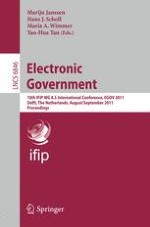2011 | Book
Electronic Government
10th IFIP WG 8.5 International Conference, EGOV 2011, Delft, The Netherlands, August 28 – September 2, 2011. Proceedings
Editors: Marijn Janssen, Hans J. Scholl, Maria A. Wimmer, Yao-hua Tan
Publisher: Springer Berlin Heidelberg
Book Series : Lecture Notes in Computer Science
